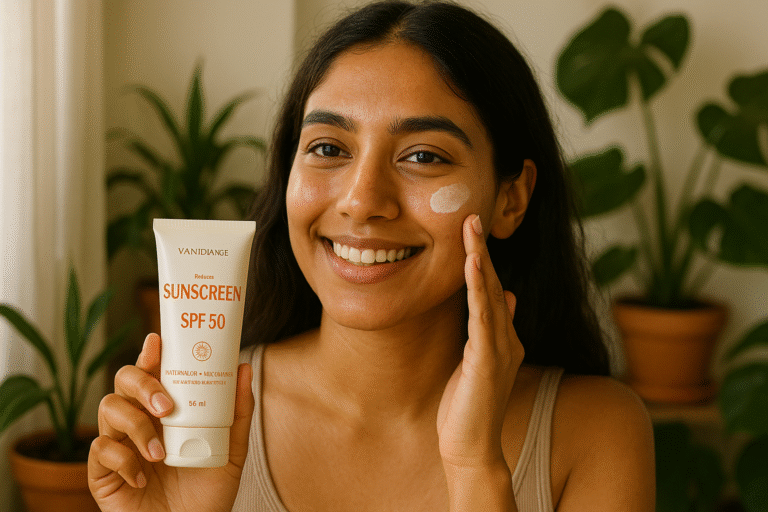If you are dealing with acne this season, you are not alone. It is normal to feel overwhelmed.A thoughtful monsoon skincare routine can help, especially since humidity and pollution can cause more breakouts. It can be hard to understand what causes acne and how each step in your routine helps, especially if you are unsure which products to use. It’s frustrating, and that is perfectly okay. The good news is that with patience and the right information, you can manage your acne. You can also create an effective skincare routine and find treatments that work for you. You have the power to take steps toward clearer skin and a brighter look.
What is the cause of acne?
Determining the exact cause of your acne infection can be quite challenging, as the reasons can vary from person to person. Research suggests that various factors may contribute to this skin disorder, including poor diet, stress, environmental conditions, hormonal changes, and even genetic influences.
Understanding Monsoon Acne Challenges
Monsoon humidity in India is very high. This muggy weather traps sweat and oil on your skin, which can clog pores and cause pimples. During the monsoon, breakouts are common because of this trapped sweat and oil. Rainwater and pollution can also bring bacteria, increasing redness and inflammation. It’s understandable to feel frustrated when you expect clear days but get unwanted acne instead. However, knowing these causes can help you adjust your skincare routine.
For example, the Times of India says you shouldn’t skip moisturizer just because it’s humid. Instead, use a light, non-greasy moisturizer to balance your skin. Protecting your skin from the sun is still important, even on cloudy days. Your skin needs a consistent routine of cleansing, hydrating, and protecting, even in wet weather. With gentle and patient care, you can manage acne during the monsoon season.
Monsoon Skincare Routine for Acne-Prone Skin
- Gentle Cleansing (Morning & Night): Cleanse your face twice daily with a mild, soap-free cleanser and lukewarm water to remove excess oil, sweat, and grime. Choose a gentle, non-comedogenic cleanser suited to your skin type. Avoid scrubbing hard or over-washing, as this can strip natural oils and cause increased oiliness. Gently pat your skin dry with a soft towel. If you’ve been sweating or caught in the rain, it’s wise to cleanse again to remove any bacteria.
- Light Exfoliation 1–2 Times a Week: To prevent clogged pores, exfoliate gently once a week, using a mild scrub or a DIY mask. For a simple mask, mix gram flour (besan) with turmeric and a splash of water or yogurt, then apply and scrub gently in circular motions before rinsing off. According to The Times of India, regular exfoliation helps remove dead skin cells and prevent clogged pores, especially during monsoon breakouts. Avoid harsh beads and excessive scrubbing to protect sensitive skin.
- Moisturize Daily: Even acne-prone skin needs hydration, even in humid weather. Choose a lightweight, oil-free lotion or gel-cream, like aloe vera gel, for moisture without greasiness. Use a non-comedogenic moisturizer to balance oil production. Apply it right after cleansing on slightly damp skin to lock in moisture and prevent excess oil that can worsen acne.
- Broad-Spectrum Sunscreen: UV rays can penetrate clouds, so don’t skip sunscreen. Use a gel-based, non-oily formula with at least SPF 30 every morning to protect against sunspots and inflammation. Even on cloudy days, sunlight can affect your skin, so reapply if you’re outdoors. Choose a lightweight sunscreen to prevent a shiny look and clogged pores.
- Nighttime Treatment: In the evening, use a gentle toner or alcohol-free witch hazel after cleansing to tighten pores. For active pimples, apply diluted tea tree oil or a small amount of benzoyl peroxide directly to the blemish to reduce redness. Finally, finish with a light moisturizer for overnight healing.
Natural Remedies and Home Remedies for Monsoon skincare routine
-
Neem & Turmeric: Neem is great for acne-prone skin. A neem and turmeric paste can help fight pimples due to neem’s antiseptic, antibacterial, and anti-inflammatory properties. You can use neem soap or make a paste from fresh neem leaves, applying it for 10 minutes before rinsing. Turmeric also aids in fading scars, but remember to patch test first and be mindful of turmeric stains.
-
Aloe Vera Gel: Pure aloe vera or a 100% aloe vera gel is soothing and mainly consists of water, providing cooling and anti-inflammatory effects. It moisturizes without greasiness, making it ideal for oily skin, and helps heal pimples. Apply a thin layer of the gel onto your face. According to NDTV, aloe vera can relieve skin irritation and prevent breakouts in humid weather, and it can be used as an overnight calming treatment.
-
Clay (Multani mitti) Mask: Clay masks can be used weekly. If Multani mitti isn’t available, fuller’s earth or bentonite clay are good alternatives. They help unclog pores and absorb excess oil, which can reduce acne. For added moisture, mix the clay with a spoonful of honey or yogurt.
-
Besan (Gram Flour) Packs: A classic and affordable remedy is a mixture of gram flour (besan) and turmeric (haldi). Combine 1-2 tablespoons of gram flour with a pinch of turmeric and enough water or yogurt to form a smooth paste. Apply it to your face for 15-20 minutes, then rinse. This blend helps absorb oil, cleanses pores, and may prevent new pimples.
Dealing with acne during the monsoon can be really tough, and it’s completely normal to feel frustrated. Just remember that improvement takes time, and with patience and consistency, things will get better. Try to keep your skincare routine simple and gentle, tailored to your unique needs. It’s important to be kind to yourself throughout this journey, as clear skin doesn’t happen overnight. You deserve to feel confident and comfortable in your own skin, even on those rainy days.

